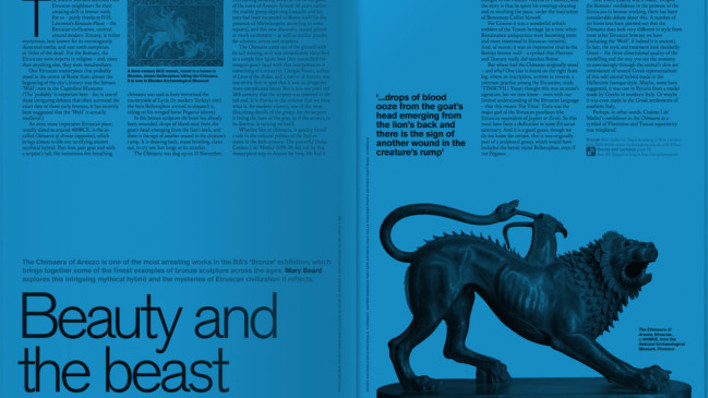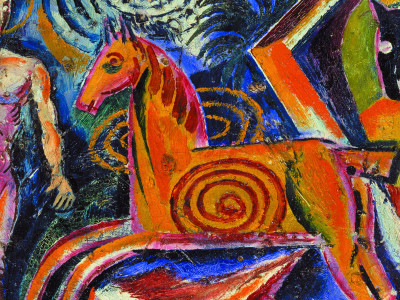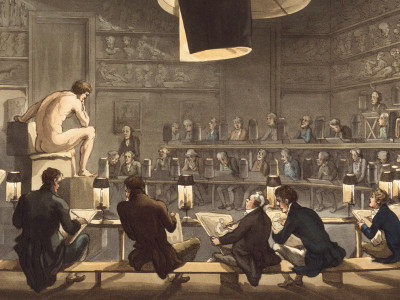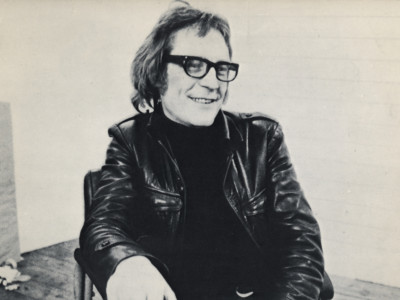
Jock McFadyen RA: postcards from a post-apocalyptic future
By Matthew Beaumont
Published on 28 February 2022
Far from evoking the past, Jock McFadyen RA’s eerie paintings imagine a dystopian future, writes Matthew Beaumont, as he prepares to meet the artist for his RA show, 'Tourist without a Guidebook'.
Matthew Beaumont is Professor of English Literature at University College London. His books include The Walker: On Finding and Losing Oneself in the Modern City (Verso).
I’d always thought of Jock McFadyen’s paintings, which I first encountered a couple of decades ago, as something like postcards from a post-apocalyptic future. This is what the city will have become, they seemed to announce, in the future perfect tense. The city will have been radically depopulated. Its buildings will have been abandoned. London’s East End edgelands will have encroached on its ancient high streets. The city’s air will hum with an eerie silence.
Spending the day with McFadyen last winter, shortly after the end of a strict Covid lockdown, I understood that we already inhabit this city. Walking from his home in Bethnal Green to his studio beside London Fields, after a morning spent talking and drinking coffee, we encountered a scattered population of people who were only tentatively returning to the city from which they had been excluded. On the streets and canal paths, under a cold, bright sun that almost made one’s eyes ache, they were reconnoitring it with curiosity and uncertainty.

This semi-alien city, which many of us first became conscious of during the pandemic, is the one that McFadyen has always occupied, always depicted. It is a city seen from the perspective of someone who, like the novelist J.G. Ballard, has always known that the slightest catastrophe might transform everything, because everything is secretly already other than we take it to be. This semi-alien city is the city that, before the pandemic, we simply chose to overlook. McFadyen didn’t.
It is a city that, shockingly, doesn’t seem to need us. The emptiness of so many of his paintings is a sign of this, as a new display at the Academy shows. Sometimes, as in one of Edward Hopper’s melancholic snapshots of the metropolis’s loneliest, most anonymous spots, McFadyen’s paintings contain isolated individuals, seen from a distance, who have for some reason been unable to escape the city and who appear to be patiently waiting for us to return to its suddenly unfamiliar precincts. But these atomised people merely reinforce the sense of emptiness they compromise.

Cambridge Heath , 2004

Nightser, 2019

Nightbus, 2020
Look at Cambridge Heath (2004; above), in which a petrol station located less than a minute’s walk from where McFadyen lives appears as if it has been transposed to the moon. The work’s sole presence is a silent man maintaining a solitary vigil in the BP Shop. Or The Shore Ditch (2019), which contains three unconnected figures who listlessly patrol a perimeter wall like lost souls hoping that, if they wait long enough, they will finally be given permission to enter the mysterious compound into which they cannot see. But the space behind the wall, the painting implies, will probably be as empty as the immense, pale blue sky above them.
In a culture committed to the commerce of regeneration, particularly in the East End of London, where he has lived for many decades, McFadyen is interested in documenting the signs of its antithesis. In his distinctive universe, processes of degeneration have a peculiar vitality. A peculiar fascination. As we crossed and recrossed Mare Street on that brittle, glittering day last winter, I was struck by a comment he made in passing about the United States: "People don’t realise America is a Third World country." Under his gaze, Britain too looks like a developing country. Or an undeveloping one.
McFadyen’s pictures, with their loving attention to the processes of evolution and devolution, are not cityscapes so much as urban landscapes. They are scrupulously concrete records of the sedimentation of the built environment, especially the erasures this entails. And, in this respect, they restore a rich, though unsentimental, sense of the historical past to the amnesiac conditions of the present. But, in their troubling abstraction, which McFadyen builds up through a highly textured application of oils, some of it wet-on-wet, they also trace the subtle transformation of these specific places into… spaces. Empty, nameless spaces.

Examining some of McFadyen’s vast, mainly rectangular canvases, which are stacked on the first floor of his warehouse studio, I felt that, even as I looked at them, his characteristic locations, the discarded cinemas, disused factories and untenanted office blocks, were in the process of transmuting into the remnants of some lost and nearly forgotten civilisation. Goodfellas (2001; above), for instance, reconstructs the blank facade of a nightclub marooned on a road in Dagenham. Here, the activities that the inscriptions above its doors and windows advertise – Music, Dancing – recall vanished anthropological rituals. The club itself, of course, has long ceased to exist.
There is an uncanniness to McFadyen’s compositions, then, that is derived in part from this sense that they commemorate a past that is sliding, at infinitesimal pace, into the realm of myth; a culture that is steadily deliquescing into nature. I was reminded of the image of a steam train "abandoned for many years to the delirium of a virgin forest" that André Breton included in the Surrealist journal Minotaure. McFadyen’s emblems of modernity, too, are susceptible to the treacly delirium of organic decay.
There is a fantastical quality too, which has recently resurfaced more explicitly. Paintings like Nightsters and Nightsters 2 (both 2019), or Nightbus (2020), portray strange, almost mythological figures who are half-gods, half-beasts. Grotesque, they are nonetheless sympathetically rendered. Happening to place these pictures beside Goodfellas, his depiction of the Dagenham club painted 20 years ago, McFadyen explained, in characteristically laconic, mischievous tones, that "it occurred to me that these nightclub pictures might actually depict the inhabitants of such a place". The 19th-century German poet Heinrich Heine speculated that, after the rise of Christianity, the exiled pagan gods disguised themselves in animal shapes and hid in remote places. Here, they reappear as punters in McFadyen’s paintings, subsisting in a club in Dagenham. There they go, riding the nightbus back to their bedsits. Godfellas? Dogfellas?
McFadyen’s paintings are records of the overlooked aspects of everyday life in the metropolitan city and, at the same time, attempts to grasp the future that these details anticipate. A future at once outlandish and real; remote and all too immediate. He is not only a ‘tourist without a guidebook’ as the show’s title suggests, but, as the art critic Tom Lubbock once remarked, a "sightseer" without one. This in a double sense: McFadyen sees the sights that we fail to notice in the streets, and acts as a 21st-century seer.
Jock McFadyen: Tourist Without a Guidebook, Weston Rooms, Royal Academy of Arts, London, until 10 April 2022
More works in 'Jock McFadyen RA: Tourist without a Guidebook'

Olympia 2, 2011
Olympia 2 features two iconic structures of the London 2012 Olympics: the Olympic stadium and the Orbit Tower designed by Sir Anish Kapoor RA, but they are obscured by hoardings adorned with graffiti, one looping red scrawl laconically echoing the shape of the Orbit. Ever alert to changes in the urban environment, McFadyen highlights the multiple competing forces that shape our cities

Harvey 2, 2018
Several of McFadyen’s recent nightclub paintings feature ‘Harvey’, a reference to American actor Harvey Keitel, known for his portrayal of morally ambiguous and ‘tough guy’ characters.
Harvey 2 is also a self-portrait, features pressed close to the picture plane, the morbidity of the flesh clearly visible, a red gash on the forehead.
As McFadyen puts it: ‘We’ve all been in those bars where we’ve split up with somebody and gone for a drink alone, and found ourselves in those situations, and that’s what I was fishing for in these paintings’
Bank, 1997
To the casual London Tube traveller there would be ‘nothing to see here’, merely the scruffiness of a brick-lined station tunnel, where posters have been removed. McFadyen, however, finds the painterly possibilities in this palimpsest of urban life. The triptych format is unusual in the artist’s oeuvre; the Brick Lane studio that he was renting at the time was not big enough for a single canvas this size. Scale is important because it gives the viewer the equivalent encounter to standing a track’s width from the posters, filling our visual field

From the Greenway 3, 2003
From the Greenway depicts the first office blocks that transformed the Isle of Dogs into the upmarket financial district of Canary Wharf. A sublime sunset glows orange behind the new, artificially illuminated glass skyscrapers, while a brightly lit commuter train crosses the middle distance on the right. The grandeur of nature is matched by the ambition of urban transformation.
Less salubrious in the foreground is the scrubland of the Greenway, the road that covers London’s sewage outflow pipe, where assorted attempts at regeneration include a pathway across the marshland and a metal archway. The contrasts inherent in this scene are matched by McFadyen’s virtuosic display of different techniques: the liquid density of the clouds swept over a luminous underlayer; the scrubland rendered in thick impasto on a black gloss ground

Enjoyed this article?
As well as free entry to all of our exhibitions, Friends of the RA enjoy one of Britain’s most respected art magazines, delivered directly to your door. Why not join the club?
Related articles

Visions from Ukraine
19 June 2024

10 RA Schools stories through the centuries
16 May 2024

In memoriam: Mick Moon RA
1 May 2024